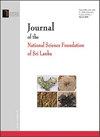Synthesis and biological evaluation of gallic acid esters as phagocyte oxidative burst inhibitors
IF 0.4
4区 综合性期刊
Q4 MULTIDISCIPLINARY SCIENCES
Journal of the National Science Foundation of Sri Lanka
Pub Date : 2023-10-12
DOI:10.4038/jnsfsr.v51i3.11199
引用次数: 0
Abstract
Several degenerative diseases, including cancer, are caused by oxidative stress, which is caused by the overproduction and accumulation of free radicals. The purpose of the study was to synthesize gallic acid (GA or 3,4,5-trihydroxybenzoic acid) esters and evaluate their anti-inflammatory potential through the inhibition of reactive oxygen species (ROS). The compounds methyl gallate (2), sec-butyl gallate (3), ethyl gallate (4), isopropyl gallate (5), 2-methoxyethyl gallate (6), 4-methoxybutyl gallate (7), 2-methylbutyl gallate (8) and pentan-3-yl gallate (9) were synthesized. 1H NMR, MS and IR data are reported for compounds 2-9, and 13C NMR data for compounds 2, 3, 5, and 6. The molecular formulae of compounds 3 and 7-9 were established by HREI-MS spectroscopic data. All the synthesized compounds were tested for their anti-inflammatory and cytotoxic activities by chemiluminescence and MTT cytotoxicity assay respectively. The results revealed the anti-inflammatory potential of compounds 2-8 with an IC50 range between (13.3 – 54.3 µM) as compared to the standard anti-inflammatory drug, Ibuprofen (IC50 = 54.3 ± 9.2 μM). The most potent inhibitors were found to be compound 3 (ROS IC50 = 15.0 ± 6.6 µM) and compound 7 (ROS IC50 = 13.3 ± 0.8 µM). All compounds were found to be non-cytotoxic in the NIH-3T3 fibroblast cell line. Compounds 3, 7- 9 were identified as new compounds.没食子酸酯作为吞噬细胞氧化爆发抑制剂的合成及生物学评价
一些退行性疾病,包括癌症,都是由氧化应激引起的,氧化应激是由自由基的过度产生和积累引起的。本研究的目的是合成没食子酸(GA或3,4,5-三羟基苯甲酸)酯,并通过抑制活性氧(ROS)来评价其抗炎潜能。合成了没食子酸甲酯(2)、没食子酸正丁酯(3)、没食子酸乙酯(4)、没食子酸异丙酯(5)、没食子酸2-甲氧基乙基(6)、没食子酸4-甲氧基丁酯(7)、没食子酸2-甲基丁酯(8)和没食子酸戊烷-3-基(9)。报道了化合物2-9的1H NMR、MS和IR数据,以及化合物2、3、5和6的13C NMR数据。通过HREI-MS数据确定了化合物3和7-9的分子式。采用化学发光法和MTT细胞毒法分别测定合成化合物的抗炎活性和细胞毒活性。结果表明,化合物2 ~ 8与标准抗炎药布洛芬(IC50 = 54.3±9.2 μM)相比,IC50范围在(13.3 ~ 54.3µM)之间。化合物3 (ROS IC50 = 15.0±6.6µM)和化合物7 (ROS IC50 = 13.3±0.8µM)抑制作用最强。所有化合物在NIH-3T3成纤维细胞系中均无细胞毒性。化合物3、7 ~ 9为新化合物。
本文章由计算机程序翻译,如有差异,请以英文原文为准。
求助全文
约1分钟内获得全文
求助全文
来源期刊

Journal of the National Science Foundation of Sri Lanka
MULTIDISCIPLINARY SCIENCES-
CiteScore
0.90
自引率
0.00%
发文量
57
审稿时长
>12 weeks
期刊介绍:
The Journal of National Science Foundation of Sri Lanka (JNSF) publishes the results of research in Science and Technology. The journal is released four times a year, in March, June, September and December. This journal contains Research Articles, Reviews, Research Communications and Correspondences.
Manuscripts submitted to the journal are accepted on the understanding that they will be reviewed prior to acceptance and that they have not been submitted for publication elsewhere.
 求助内容:
求助内容: 应助结果提醒方式:
应助结果提醒方式:


